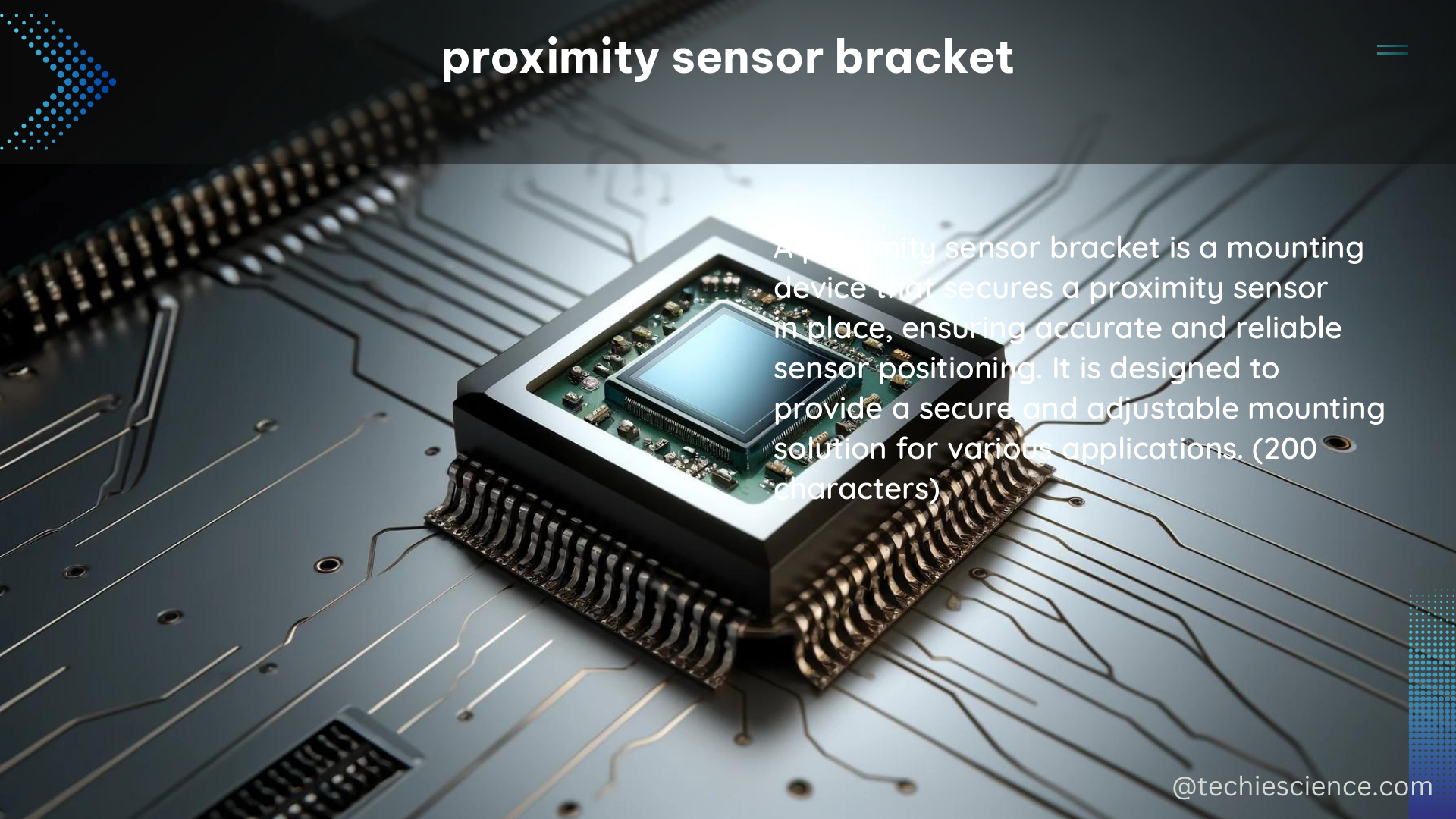Proximity sensor brackets are essential components of proximity sensor systems, providing a stable and secure mounting for the sensors. These brackets play a crucial role in ensuring the accuracy and reliability of proximity measurements by considering factors such as the sensor’s size, sensing distance, and active face diameter, as well as the environmental conditions in which the sensor will be used.
Understanding the Technical Specifications of Proximity Sensor Brackets
The technical specifications of a proximity sensor bracket can vary depending on the sensor it is designed to hold. For instance, the Rockwell Automation Proximity Sensor Specifications Technical Data provides details on the mounting of a tubular proximity sensor, including the bracket’s threading and the mounting nut’s role in securing it.
Tubular Proximity Sensor Mounting
- Bracket Threading: The proximity sensor bracket for a tubular proximity sensor typically features a threaded mounting hole, allowing the sensor to be securely attached.
- Mounting Nut: The mounting nut plays a crucial role in securing the proximity sensor to the bracket, ensuring a stable and secure installation.
- Sensing Distance: The sensing distance of the proximity sensor is a critical factor in determining the dimensions of the bracket, as the bracket must be designed to position the sensor at the optimal distance from the target object.
- Active Face Diameter: The active face diameter of the proximity sensor, which is the area of the sensor that detects the presence of an object, is another important consideration in the bracket’s design.
Wearable Proximity Sensor Brackets
In the context of wearable proximity sensors, as described in the study “Wearable Proximity Sensors for Monitoring a Mass Casualty Incident,” the bracket takes the form of a transparent envelope fixed to the participant’s chest. This design allows for the detection of person-to-person interactions while minimizing interference with the participant’s movement.
- Envelope Design: The transparent envelope design of the wearable proximity sensor bracket ensures that the sensor can detect interactions without obstructing the participant’s movement.
- Attachment Method: The bracket is fixed to the participant’s chest, allowing for accurate proximity measurements during the study.
- Reference Points: The study also mentions the use of fixed tags placed on the ceiling of hospital rooms, which serve as reference points for proximity measurements.
Integrated Wearable Proximity Sensor Brackets
In the study “Using wearable proximity sensors to characterize social contact patterns,” the bracket is integrated into the wearable sensor, which is attached to the participant’s chest.
- Sensor Integration: The proximity sensor is directly integrated into the wearable bracket, creating a compact and streamlined design.
- Proximity Data Collection: The sensor’s proximity data is used to estimate the distance between individuals and identify contact events based on a specified attenuation threshold.
- Attenuation Threshold: The attenuation threshold is set at −75 dBm, allowing for the detection of proximity events between devices situated in the range of 1-1.5 m of one another.
Factors Influencing Proximity Sensor Bracket Design

The design of proximity sensor brackets must consider various factors to ensure accurate and reliable proximity measurements.
Environmental Conditions
- Industrial Environments: In harsh industrial environments, the proximity sensor bracket must be robust enough to withstand vibrations, temperature fluctuations, and other mechanical stresses.
- Wearable Applications: For wearable proximity sensors, the bracket must be lightweight, unobtrusive, and comfortable for the wearer, without compromising the sensor’s performance.
Sensor Orientation and Placement
- Optimal Positioning: The bracket’s design should allow for the precise positioning of the proximity sensor, ensuring that it is oriented correctly and placed at the optimal distance from the target object.
- Power Consumption: The bracket’s design can impact the sensor’s power consumption and battery life by ensuring that the sensor is not detecting unnecessary objects or interference.
Conclusion
Proximity sensor brackets are essential components of proximity sensor systems, playing a crucial role in ensuring the accuracy and reliability of proximity measurements. By understanding the technical specifications and design considerations of these brackets, users can ensure that their proximity sensor systems are optimized for their specific applications, whether in industrial environments or wearable devices.
Reference:
- Rockwell Automation. (2023). Inductive Proximity Sensor Specifications Technical Data. Retrieved from https://literature.rockwellautomation.com/idc/groups/literature/documents/td/prox-td001_-en-p.pdf
- Ozella, L., Gauvin, L., Carenzo, L., Quaggiotto, M., Ingrassia, P. L., Tizzoni, M., … & Cattuto, C. (2019). Wearable Proximity Sensors for Monitoring a Mass Casualty Incident Exercise: Feasibility Study. PLOS ONE, 14(5), e0217133.
- Vanhems, P., Nussbaumer, P., & Clumeck, N. (2021). Using wearable proximity sensors to characterize social contact patterns in a village in rural Malawi. EPJ Data Science, 10(1), 1-18.

The lambdageeks.com Core SME Team is a group of experienced subject matter experts from diverse scientific and technical fields including Physics, Chemistry, Technology,Electronics & Electrical Engineering, Automotive, Mechanical Engineering. Our team collaborates to create high-quality, well-researched articles on a wide range of science and technology topics for the lambdageeks.com website.
All Our Senior SME are having more than 7 Years of experience in the respective fields . They are either Working Industry Professionals or assocaited With different Universities. Refer Our Authors Page to get to know About our Core SMEs.